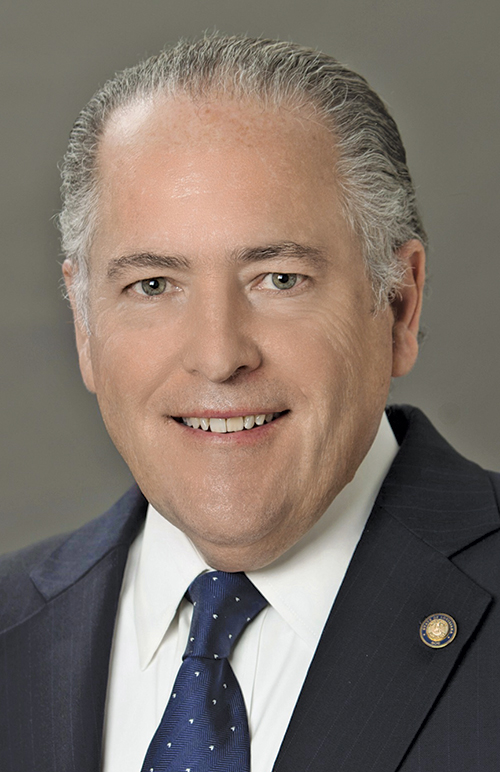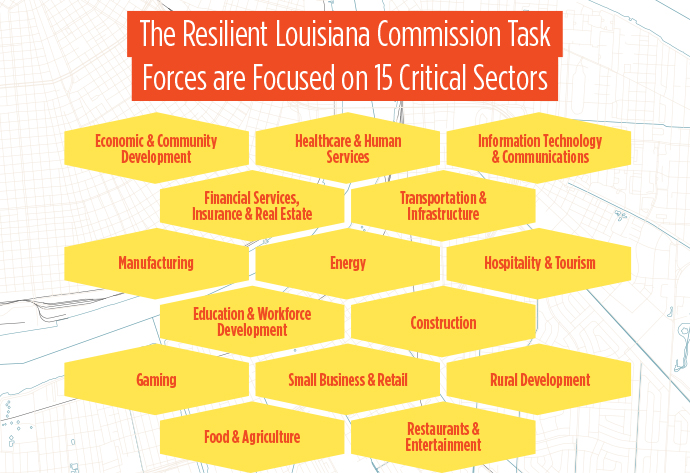In late June, we visited with Louisiana Economic Development Secretary Don Pierson to find out how his state is faring now that the business world is largely turned on its ear. It turns out Louisiana’s highly acclaimed workforce training programs are agile enough to work well in a pandemic. Among other revelations, rocket science is meeting river science in the Mississippi River Delta region. Secretary Pierson explains these and other Bayou State developments in the following interview.
Site Selection: How are you leading Louisiana’s business community through the COVID-19 pandemic and beyond?
Sec. Pierson: In Louisiana, we’re responding in a safe, smart, swift manner. Safety comes first. In that context, Gov. John Bel Edwards acted in a smart manner to create the Resilient Louisiana Commission. With health care executive Terrie Sterling [a Baton Rouge consultant and retired Franciscan Missionaries of Our Lady Health System executive], I’m co-chairing that body, which includes 15 task forces covering every sector of the Louisiana economy. We’ve completed our first charge of advising Gov. Edwards on safely reopening the economy. In July, we complete our second charge of making long-term recommendations for a more Resilient Louisiana.
‘Resilient’ means we’re able to bounce back more quickly from crises, whether that’s a natural disaster (hurricane, flood), a manmade disaster (oil spill, catastrophic accident) or a pandemic like COVID-19.
COVID-19 is unprecedented in recent history. At Louisiana Economic Development, we are applying our expertise in recovery from other events, and we’re building a blueprint — with a great deal of public- and private-sector support — for coming back stronger than before.
Site Selection: What lessons have you learned?
Sec. Pierson: Pandemics change how we live, how we work. Case in point: After COVID-19 led to stay-at-home orders, our Business Development team coordinated GIS mapping and aerial site technology to perform a series of virtual site tours with major prospects. In one meeting, we were able to take a prospect through a complete virtual tour of a mega-site in one part of the state, then to a virtual tour of another mega-site in a different part of the state. We could not have done that so efficiently in person. Both the site selection consultants and the company officials who joined anonymously were able to ask thoughtful questions, gain deep insights and come away with a truly satisfying experience that met all of their immediate needs. We’ve done many more virtual tours, and we understand this will become even more common after COVID-19. Like other states, we are dealing with unemployment numbers that spiked in April and May — approximately 200,000 more people jobless now than in 2019 — but we also have companies hiring, who want to advance quickly. We’re helping people all along that spectrum.
Long ago, our LED FastStart® team innovated the way training is delivered to client employees, through mobile devices and 24/7 interactive training modules. Now, they’re delivering that training exclusively on virtual platforms all over the state.
Another great example: Earlier in 2020, we announced the arrival of Advanced Aero Services, an MRO [maintenance, repair, overhaul] aerospace facility in Shreveport. Their first big hiring push came during COVID-19. The company said, ‘Let’s do it, but how?’ Paul Helton and his LED FastStart team said, ‘Here’s how.’ Through a variety of strategic online engagements, and featuring Facebook, LED FastStart produced a virtual job fair that reached 170,000 people for this new Shreveport company. That’s phenomenal, because this is a company that’s beginning with 60 jobs — but they want to employ 500 by 2024 and 1,000 by the end of the decade. FastStart has the bandwidth to make the seemingly impossible possible for expanding employers.

“It’s a tremendously challenging but rewarding time to be in the economic development business.”
Louisiana also is an innovator for synchronizing high-demand jobs in industry with the delivery of curricula at all our higher education campuses, and especially at our community and technical colleges. During COVID-19, LED FastStart has moved even more training modules online for college and high school campuses — like our C4M certification for fast-tracking students to manufacturing careers. One of the abiding lessons of COVID-19 for Louisiana is that remote learning can become resilient learning; and resilient learning can mean a rewarding career for our best and brightest, no matter the physical hurdles.
We’ve also learned to look at infrastructure from a statewide perspective. After the 2005 hurricanes, there were chinks in our communications armor. We built a $700 million to $800 million independent radio network (137 towers) that provides 95% in-building, on-street coverage. It’s called LWIN [the Louisiana Wireless Information Network]. There may be a cave deep in the Kisatchie National Forest that’s a dead zone, but we’ve got virtually universal coverage, even if the commercial grid goes down. It’s the largest statewide radio system in the nation. LWIN supports voice communication for 100,000 federal, state, local and NGO users every day, with full state maintenance and no user fees. Imagine a telemedicine version of that.
Site Selection: Stepping back from the pandemic, what are some recent signature economic development achievements in Louisiana?
Sec. Pierson: Our economic development results in 2019 were the best we’ve enjoyed in years: $8.45 billion in new capital investment, more than 12,300 new jobs, over 15,500 retained jobs — all associated with 83 new project wins. That wrapped up a four-year run of $42 billion in capex, 40,300 new jobs, 36,400 retained jobs and 211 project wins.
As recently as the third quarter of 2019, Louisiana’s economy was growing at a 3% clip, which was a Top 5 performance in the U.S. Now that we’re facing COVID-19 and a sharp downturn in oil prices, we’re focusing on what has made us more resilient and more diversified in recent years. We’re accentuating our positives, while tackling our challenges.
A good example: Our oil and gas industry — while significant in some North Louisiana reserves — is certainly concentrated along the Gulf Coast. Companies are consolidating, they’re innovating with new E&P equipment and technology that’s increasingly less labor-intensive, they’re discovering new applications for their production.
One of our independent firms that expanded in Southwest Louisiana last year, Bagwell Energy Services, is seeking to fabricate as much or more for the LNG industry as for the oil and gas production side. Shipbuilders are diversifying away from oil and gas workboats to defense and tourism vessels. A longstanding drilling pipe fabricator, K&B Industries, created a whole new aerospace division to manufacture tubing for avionics and other aircraft systems.
We’re also looking to the future with a $50 billion master plan to protect and restore the Louisiana coast. CPRA, our state agency overseeing this effort, adopted its largest yearly spending budget yet for the 2021 fiscal year beginning in July: $958 million. Many Louisiana engineering, public works, environmental and construction firms are contributing to this emerging water management industry. But we want to harness more of that. We created CTAC, the Coastal Technical Assistance Center, at Nicholls State University in Thibodaux to match eligible Louisiana firms with this major project work. Central to this whole industry is our 35-acre Water Campus. It’s conveniently situated between downtown Baton Rouge and the flagship LSU campus. We’ve already seen over $100 million in capital investment there for research, professional office, residential and event space.
The LSU Center for River Studies has one of the world’s largest movable-bed physical models for river research — and it empowers researchers to study the entire lower Mississippi River Delta through water and sediment injections. It includes 18 acoustic sensors calibrated to U.S. Army Corps of Engineers river gauges, and 20 high-def projectors that illuminate and bring the river and coast vividly to life. This really is rocket science-meets-river science.
The Baton Rouge Area Foundation is leading campus-wide development, and CPRA, LED, LSU, the City of Baton Rouge and East Baton Rouge Parish are partners, along with private sector firms locating on the Water Campus.
One of the linchpins of the Water Campus is The Water Institute of the Gulf, a nonprofit, applied research institute of scientists and engineers who are doing work all over the world. They’ve forged research partnerships with Deltares in The Netherlands and Ben-Gurion University in Israel, among others, to solve global water challenges. For all these reasons, we think Louisiana can be the Silicon Valley of water management.
Oil and gas remains big business in Louisiana, but it’s evolving to smarter deployment of capital and human resources in a world of tighter margins. With climate change, water management we know will be a huge industry going forward. And our downstream energy sectors are doing well with affordable, abundant natural gas.

ExxonMobil Baton Rouge is advancing a half-billion-dollar polyolefins expansion; Shell Chemical in Ascension Parish [Geismar] is planning a $1.2 billion monoethylene glycol expansion; and Formosa’s FG LA project between Baton Rouge and New Orleans is in preconstruction, with what we expect will be a final investment decision soon for a $9.4 billion ethylene complex. The FG project will produce the building blocks of plastics, and we’re seeing continued growth in that same industry from Shintech, Dow Chemical, Exxon Mobil, BASF, Westlake Chemical, Lotte Chemical and others in that industry. We have strong fundamentals on the industrial side.
Our key immediate goal is bringing back our critically important service industries and small businesses to that they can support and enable this long-term, systemic industrial growth for which Louisiana is renowned. We’re optimistic that our recovery and resiliency efforts will position us to be better, and stronger, than we were prior to COVID-19.
One more critical sector for Louisiana in the next decade is federal defense and aerospace. Through our Louisiana Military Advisory Council and LED project management, we’re engaging Congress, the Pentagon and the White House in ways that can make our military installations more resilient in Louisiana. They create $8 billion in economic output across our state annually, and we want to leverage that, tie it to our higher education campuses, our technology sector and our rural communities to maximize what the U.S. military means to Louisiana families and their quality of life.
I know you’re well aware, but we continue to be excited about the progress NASA is making in Space Launch System rocket production and Ares crew capsule development at our Michoud Assembly Facility in New Orleans. When U.S. astronauts return to the moon this decade, and later to Mars, it will because Louisiana men and women applied their intelligence, their dedication, their innovation and their spirit to making these missions successful.
Site Selection: Anything else you’d like to add?
Sec. Pierson: We look forward to your continuing coverage of COVID-19 and its impact on the site selection and economic development world. Best practices are essential at this time, and we can learn so much more about what’s working well and what needs to change by reading your comprehensive coverage.
Let’s hope that we can be talking about a more normal state of affairs in 2021, but also that we can be talking about some evolutionary changes and some revolutionary innovation that took place because of COVID-19. It’s a tremendously challenging but rewarding time to be in the economic development business.

